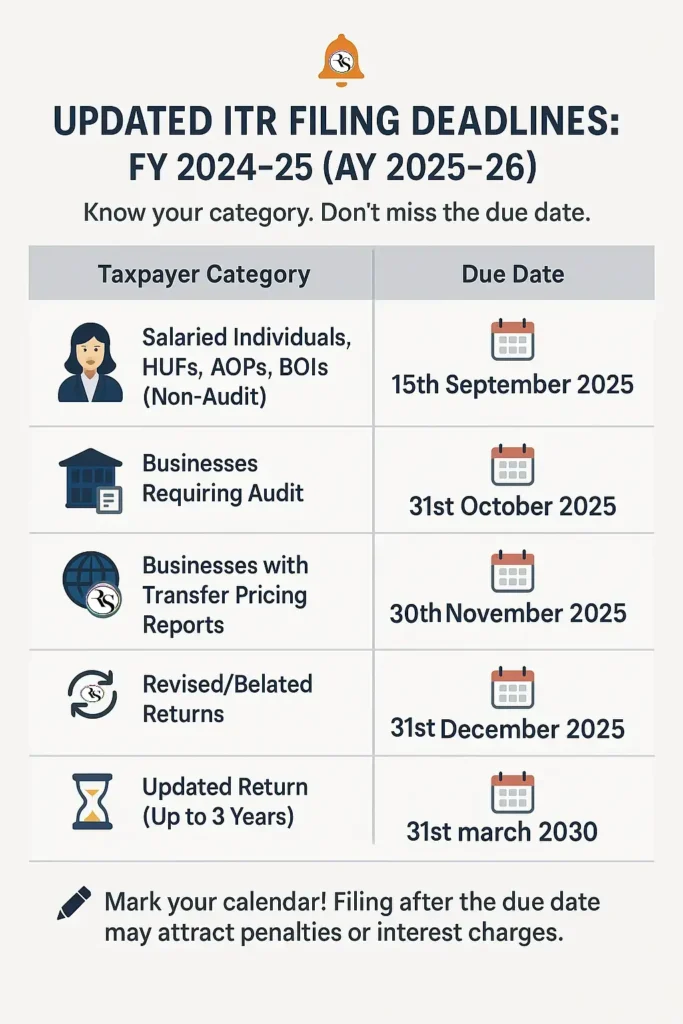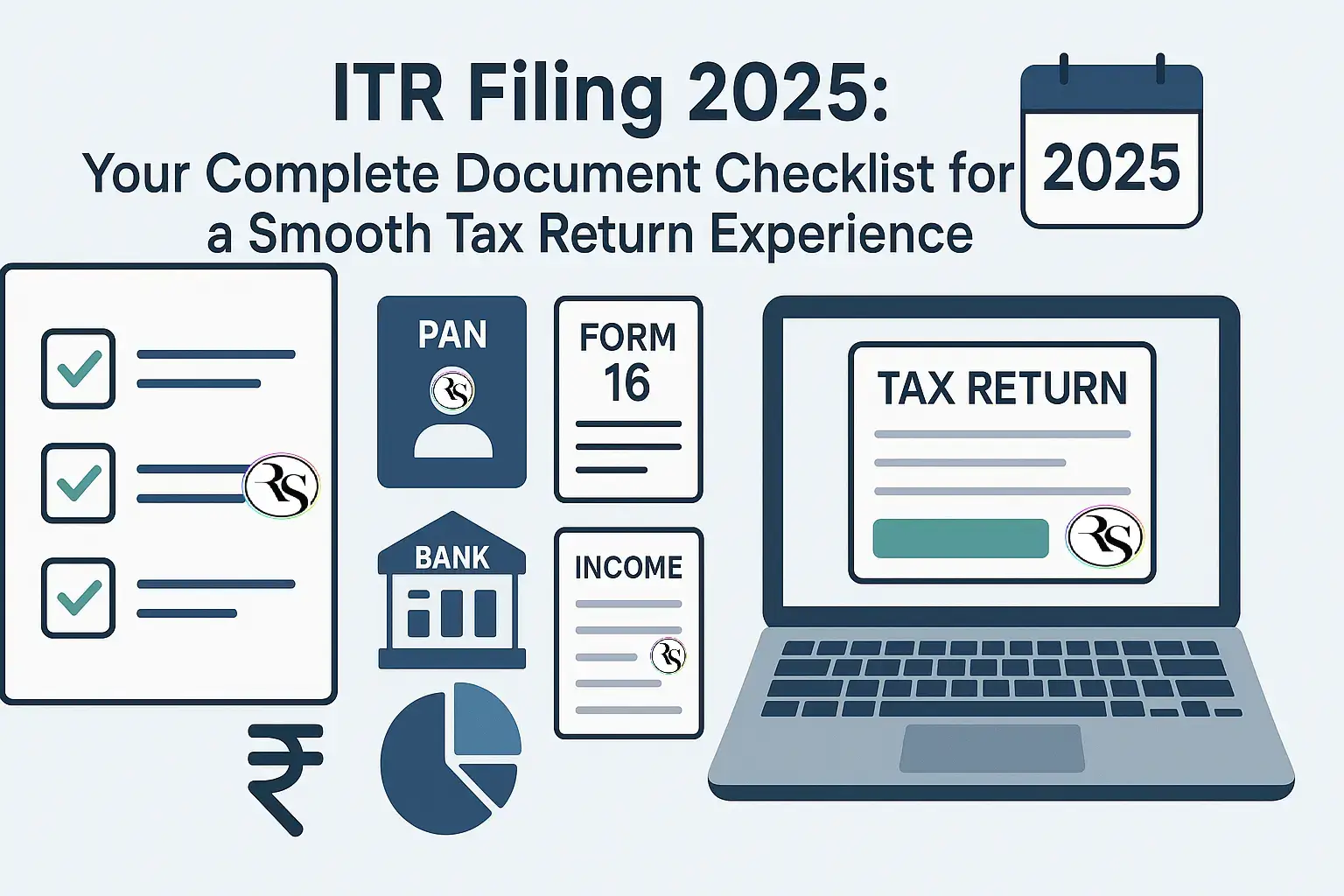The 2025 Income Tax Return (ITR) filing season is here, and there are important changes to take note of — from extended deadlines to updated ITR forms and a more streamlined filing process. Whether you’re a salaried employee, business owner, or investor, understanding what’s new can help you file your taxes smoothly and avoid penalties.
📅 Updated ITR Filing Deadlines (FY 2024–25 / AY 2025–26)
The government has extended the deadlines for most taxpayers to give everyone more time to prepare and file their returns properly, especially considering recent updates to ITR forms and system changes.

Mistakes to Avoid While Filing ITR for FY 2024-25 (AY 2025-26):
Filing your ITR late or in haste can lead to costly errors. Key mistakes to avoid:
- Wrong ITR Form: May lead to penalties (up to 200%) and an invalid return.
- Mismatch in Form 26AS/AIS: Can trigger tax notices and penalties.
- Missing the Due Date: Attracts late fees (up to INR 5,000) and interest; some deductions may be lost.
- Not E-Verifying: ITR must be e-verified within 30 days, or it becomes invalid.
- Fake Deductions/HRA Claims: Treated as misreporting; penalties up to 200% plus interest apply.
📃 Essential Documents for a Smooth Filing Experience
Starting early and organizing your paperwork can make tax filing much easier. Here’s a checklist of what you’ll need:
Personal and Income Details
- Previous year’s ITR (for reference)
- Form 16 (salary + TDS from your employer)
- Form 26AS (summary of taxes deducted/paid)
- AIS (Annual Information Statement – high-value financial transactions)
- Capital gains statements (from sale of stocks, mutual funds, or assets)
- Income details from freelancing, consulting, pension, etc.
- Rental income details (if applicable)
Interest and Tax Deduction Documents
- Interest certificates from banks (savings and FDs)
- TDS certificates (if any)
Investment & Deduction Proofs
- Section 80C: PPF, ELSS, NSC, Life Insurance premiums
- Section 80CCD(1B): NPS contributions
- Section 24B: Home loan interest certificate (up to ₹2 lakh)
- Section 80E: Education loan interest certificate
- Section 80G: Receipts for eligible charitable donations
📝 Choosing the Right ITR Form: Don’t Get It Wrong
Picking the right ITR form is critical. Filing with the wrong form can result in your return being considered “defective” — meaning you might have to re-file. Here’s what’s new for FY 2024–25:
- ITR-1 (Sahaj):
- For resident individuals with income up to ₹50 lakh from salary, one house property, and other sources.
- Now allowed for individuals with capital gains under ₹1.25 lakh from stocks or mutual funds (if there are no losses to carry forward and other simple conditions are met).
- ITR 2:
For individuals/HUFs with income from salary, multiple properties, capital gains, foreign income, or holding directorship in companies.
- ITR-2 Updates for AY 2025–26:
- ITR-2 can now be filed online with pre-filled data via the e-filing portal.
- Capital losses from share buybacks must be reported in Schedule CG (if related dividends are disclosed).
- New row added for dividend income under Section 2(22)(f).
- Separate reporting of land/building acquisition and improvement costs based on transaction date (before/after July 23, 2024).
- Asset and liability disclosure are now mandatory for income above ₹1 crore (previously ₹50 lakh).
- Capital gains split into pre- and post-July 23, 2024, for correct tax rate application.
- TDS schedule includes a new field to specify the deduction section code.
- Enhanced details required for deductions under Sections 80C, 24(b), HRA, etc.
- ITR 3:
- For individuals/HUFs having income from business/profession, including as partner in firms, along with salary and other incomes.
- ITR 4 (Sugam):
- For resident individuals, HUFs, and firms (not LLPs) opt for presumptive income under Sections 44AD, 44ADA, or 44AE.
📌 When in doubt, consult a tax expert.
⚠️ Penalties for Late Filing
If you miss your deadline:
- Section 234A: 1% interest per month on unpaid taxes
- Section 234F: Late filing fees (up to ₹5,000 depending on income)
✅ Key Takeaways
- Know your due date — it’s not the same for everyone.
- Start collecting documents early to avoid a last-minute rush.
- Use the correct ITR form to avoid filing errors.
- Use the extended timeline wisely to ensure accuracy and maximize deductions.
By staying informed and organized, you can make your ITR filing for FY 2024–25 smooth, accurate, and penalty-free. Take advantage of the extended deadlines, follow this checklist, and file with confidence!
📌 Disclaimer: This content is for informational purposes only. Please consult a tax professional before making any financial or tax-related decisions.
Note: Tax rates and exemptions are subject to change as per the latest Finance Act. This infographic is for informational purposes only. Please consult a tax advisor for personalized guidance.
